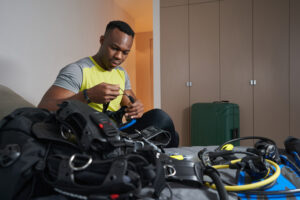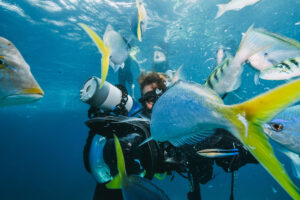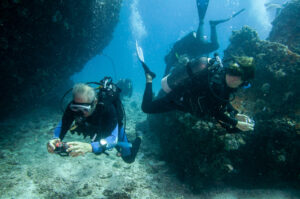What is an Alternative Air Source?
Scuba diving is a popular underwater recreational activity that allows divers to explore the underwater world, observe marine life, and experience the unique sensation of being weightless. To ensure a safe and enjoyable experience, divers rely on a variety of equipment, including an alternative air source (AAS). The alternative air source serves as a secondary supply of air or other breathing gas used by the diver in emergency situations. In this entry, we will explore the importance of alternative air sources, their various types, and best practices for their use.
Importance of an Alternative Air Source
An alternative air source is an essential piece of safety equipment for scuba divers. In the event of a primary air supply failure or other emergency situations, an AAS allows the diver to access an additional source of breathing gas, providing crucial time to safely ascend to the surface. By ensuring divers have an alternative air source, the risk of drowning or other serious accidents is significantly reduced.
Types of Alternative Air Sources
Auxiliary Demand Valve (ADV)
An auxiliary demand valve is a second-stage regulator that is attached to the diver’s primary air cylinder. The ADV is typically connected via a longer hose, allowing it to be easily shared with a dive buddy in an out-of-air emergency. The diver simply breathes from the ADV, while their buddy continues to breathe from the primary regulator. ADVs are compact, lightweight, and easy to use, making them a popular choice for recreational divers.
Pony Bottle
A pony bottle is a small, separate air cylinder that is used as an emergency backup air supply. It is typically filled with the same breathing gas as the primary air cylinder and is equipped with its own first and second-stage regulators. The pony bottle is carried by the diver, either strapped to the main air cylinder or mounted to the buoyancy control device (BCD). In case of an emergency, the diver can switch to the pony bottle, providing an independent source of air. The size of the pony bottle varies, with larger sizes offering more breathing gas and longer emergency air supply duration.
Bailout Bottle
A bailout bottle is a larger capacity, separate air cylinder that is generally used by technical and professional divers who may need a longer emergency air supply during deep or decompression dives. Similar to the pony bottle, the bailout bottle is filled with the same breathing gas as the primary air cylinder and is equipped with its own first and second-stage regulators. It can be carried by the diver or staged at a specific depth during the dive, depending on the dive plan and requirements. Bailout bottles offer more breathing gas compared to pony bottles, ensuring that divers have an adequate air supply in case of an emergency during deep or long-duration dives.
Best Practices for Using Alternative Air Sources
Regular Inspections and Maintenance
Like all scuba diving equipment, alternative air sources must be regularly inspected and maintained to ensure they remain in good working condition. It is essential to check the hoses, regulators, and cylinders for any signs of wear or damage before each dive, and to service the equipment according to the manufacturer’s recommendations.
Familiarization and Training
Divers should be familiar with their alternative air source and how to use it in case of an emergency. Proper training in the use and deployment of the AAS is essential for maintaining safety during a dive. Many scuba diving certification agencies offer courses that focus on out-of-air emergencies and the use of alternative air sources.
Pre-dive Buddy Checks
Before entering the water, divers should perform a buddy check to ensure that both they and their dive partner are familiar with each other’s equipment, including the alternative air source. This process allows divers to quickly locate and use their buddy’s AAS in an emergency situation.
Redundancy Planning
In addition to carrying an alternative air source, divers should also have a plan in place for dealing with air supply emergencies. This plan should include procedures for sharing air, signaling for help, and ascending to the surface safely. Having a well-thought-out plan and practicing it regularly can help prevent panic and ensure a swift, safe response in case of an emergency.
Gas Management
Proper gas management is crucial for maintaining safety during a dive. Divers should monitor their air consumption throughout the dive and ensure that they have enough air to safely return to the surface, including a reserve for emergencies. By keeping track of air consumption and planning dives accordingly, divers can reduce the risk of running out of air and needing to rely on their alternative air source.
Choosing the Right Alternative Air Source
The choice of an alternative air source depends on the diver’s experience level, the type of diving they plan to do, and personal preferences. Recreational divers typically opt for auxiliary demand valves due to their compact size and ease of use, while technical and professional divers may require a pony bottle or bailout bottle for added safety during deep or decompression dives. It is essential to choose an AAS that meets the diver’s needs and to practice using it regularly to ensure familiarity and confidence in its use during an emergency.
The alternative air source is a critical piece of safety equipment for scuba divers, providing a secondary supply of breathing gas in case of an emergency. By understanding the different types of alternative air sources, maintaining and inspecting equipment regularly, and practicing proper gas management, divers can ensure that they are prepared to handle out-of-air emergencies and enjoy a safe and enjoyable diving experience. Ultimately, the key to successful and safe scuba diving lies in thorough preparation, training, and adherence to best practices.

















